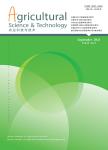High Prevalence of Eimeria Infection in Domestic Pigeons(Columba Livia Domestica) in Guangdong Province, Southern China
High Prevalence of Eimeria Infection in Domestic Pigeons(Columba Livia Domestica) in Guangdong Province, Southern China作者机构:Open Laboratory of Veterinary Public Health and Key Laboratory of Livestock Disease Prevention of Guangdong Province Institute of Animal Health Guangdong Academy of Agricultural Sciences
出 版 物:《Agricultural Science & Technology》 (农业科学与技术(英文版))
年 卷 期:2016年第17卷第1期
页 面:115-116页
学科分类:090603[农学-临床兽医学] 09[农学] 0906[农学-兽医学]
基 金:Support by the National Natural Science Foundation of China(Grant No.31402186 and 31302086) the Pearl River Science and Technology New Star Project(Grant No.2012J2200059 and 2014J2200096) the Dean Foundation of Guangdong Academy of Agricultural Sciences(Grant No.201413) the Science and Technology Plan Projects of Guangdong Province(Grant No.2015A020209075,2013B031500005,2014B070706011 and 2013B060400037)
主 题:Eimeria Pigeons Guangdong Province Southern China
摘 要:[Objective] This study aimed to make a survey of domestic pigeons for infection with Eimeria species of coccidia was conducted in Guangdong Province, southern China. [Method] A total of 244 fecal samples(102 from Huizhou, 83 from Jiangmen, 35 from Chaozhou and 24 from Guangzhou, respectively) in four pigeon breeding farms between June 2012 and March2013 were collected and examined microscopically. [Results] Eimeria oocysts were seen in 223(91.4%) fecal samples, with three species, namely E. labbeana, *** and E. kapotei. E. labbeana was the most common species in Guangdong provinces with an overall prevalence of 91.4%, while a slightly lower incidence of E. columbae and E. kapotei species was detected with11.1% and 6.6%, representatively. The prevalence in different months varied ranging from 83.3% to 91.7%, with the highest prevalence in summer. Nestling groups showed obviously high infection than adult pigeons. [Conclusion] The present survey indicated the wide and severe prevalence of Eimeria infection in Guangdong domestic pigeons, which suggested that integrated measures should be taken to control and prevent coccidiosis of pigeons in this province.



